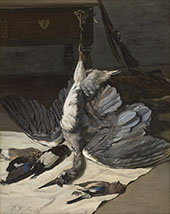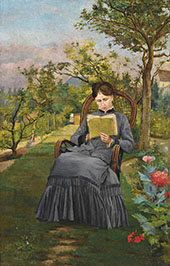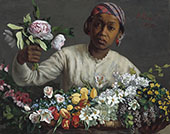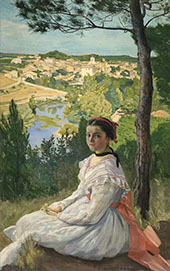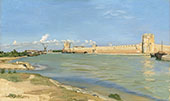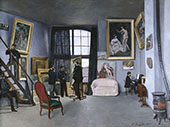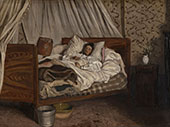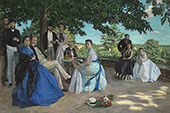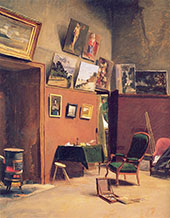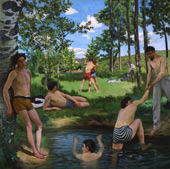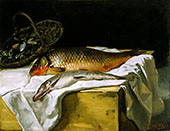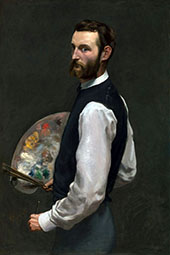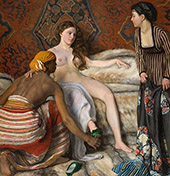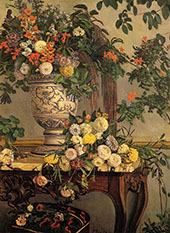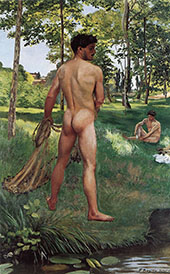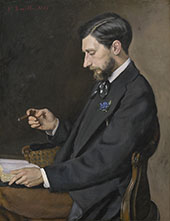Frederic Bazille Oil Painting Reproductions
Frederic Bazille replica paintings on Canvas for sale
Frederic Bazille Famous Impressionist Paintings
Frederic Bazille was a French artist and one of the key figures of the famous Impressionist art movement. Despite his short career, Bazille made significant contributions to the art world and left a lasting impact on the development of 19th century art.
This article will explore the life and art of Frederic Bazille, highlighting his famous oil paintings and his role as an Impressionist artist.
Who was Frederic Bazille?
Frederic Bazille was born in Montpellier, France, on December 6, 1841, and came from a wealthy family. Initially, Bazille studied medicine in Paris but later pursued his passion for art. He enrolled at the École des Beaux-Arts, where he studied under renowned artists like Jean-Auguste Dominique Ingres and Thomas Couture.
Bazille's famous paintings include Young Woman with Peonies, in the collection of Mr. and Mrs. Paul Mellon at the National Gallery of Art in Washington D.C., Summer Scene (Bathers), and various other oil paintings. Frederic Bazille’s contribution to the art world and his friendships with other Impressionist artists have solidified his place in art history.
Overall, Frederic Bazille's paintings are deeply intertwined with the French Impressionist movement, and his oil paintings continue to be celebrated for their innovative approach and artistic vision.
Famous Paintings by Frederic Bazille
Here are some of Frederic Bazille's famous impressionist paintings:
1. The Pink Dress 1864: Owned by the Musee d’Orsay in Paris, this portrait depicts Bazille's cousin, Therese des Hours, wearing a pink dress. The oil painting showcases his skill in capturing the play of light and shadow, a characteristic feature of the Impressionist style.
2. Family Reunion 1867: In the Musee d’Orsay in Paris, this group portrait painting portrays Bazille's family in a relaxed and informal setting. The painting reflects the influence of the Impressionist style, with its emphasis on capturing fleeting moments and natural light.
3. The Artist's Studio 1870: This self-portrait shows Bazille in his studio, surrounded by his paintings and art supplies. It highlights his dedication to his craft and offers a glimpse into his artistic process. It is also on display at the Musee d’Orsay in Paris.
4. Summer Scene Bathers 1859 by Frederic Bazille, also known as Scene d'ete, is an oil painting on canvas capturing the essence of a leisurely day by the water. This colorful oil painting uses a bright palette, loose brushstrokes, and an emphasis on capturing the effects of light and atmosphere. Although it is not specifically about bathers, it showcases Bazille's ability to depict a summer scene in his unique Impressionist art style. The painting is in the collection of the Fogg Art Museum in Cambridge, MA
Frederic Bazille's Impressionist art demonstrates his ability to capture light, atmosphere, and everyday moments, which are key elements of Impressionist paintings.
What was Frederic Bazille's influence on the Impressionist Art Movement?
Frederic Bazille had a significant influence on Impressionist art. He became friends with fellow impressionist artists Claude Monet, Pierre Auguste Renoir, and Alfred Sisley, also central figures of the Impressionist movement. These famous artists often collaborated and shared ideas, contributing to the development and evolution of Impressionism.
Bazille was particularly inspired by the plein air painting technique, which involved painting outdoors to capture the effects of natural light and atmosphere. This technique became a hallmark of Impressionist paintings, and Frederic Bazille embraced it. He believed in capturing the fleeting moments and the play of light and color in everyday scenes.
In 1874, Bazille participated in the first Impressionist exhibition, showcasing his oil paintings alongside other famous Impressionist artists. This exhibition marked a turning point for Impressionism, bringing the movement into the public eye and challenging the traditional art establishment.
Overall, Frederic Bazille's influence on Impressionist oil paintings can be seen in his friendship with other Impressionist artists, his adoption of the plein air technique, and his active participation in the movement's exhibitions. His contributions helped shape the style and direction of Impressionism, making him an important figure in art history.
Frederic Bazille's Legacy
Frederic Bazille's legacy is that his works continue to be celebrated and admired despite his untimely death at 28 during the Franco-Prussian War. His contributions to the art movement helped shape the course of modern art and influenced future generations of artists. His emphasis on capturing light and atmosphere also paved the way for developing new artistic techniques and styles.
Frederic Bazille's short but impactful career as an artist left a lasting legacy in the art world. His participation in the Impressionist movement and his unique approach to capturing light and atmosphere in his oil paintings continue to inspire and influence artists today. Through his paintings, Bazille's passion for art and his dedication to his craft shine through, making him an important figure in the history of impressionist oil paintings.
Buy oil painting reproductions of Claude Monet, Pierre Auguste Renoir, and Frederic Bazille and browse our extensive catalog of impressionist oil paintings for sale.
Buy replica paintings 100% hand painted by one of our resident professional artists. We have been creating replica paintings since 1996. Our Money Back Guarantee covers standard catalog paintings; INTERNATIONAL SHIPPING IS FREE wherever you are.
Cannot Find What You Are Looking For?
Reproduction Gallery Information
Customer Service
(Send Us A Message)
Tel: (503) 937 2010
Fax: (503) 937 2011


